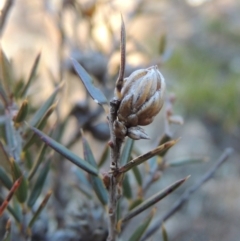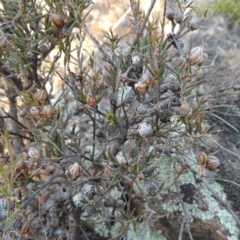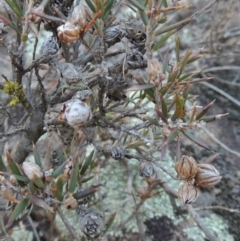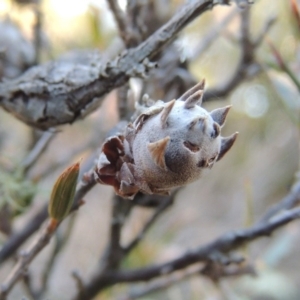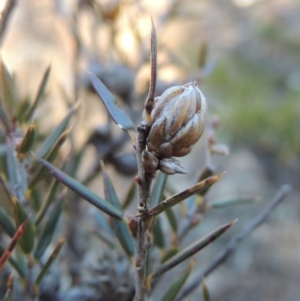1 Peach Heath at Greenway, ACT
Identification history
| Lissanthe strigosa subsp. subulata | 12 Aug 2018 | michaelb | ||
| Lissanthe strigosa subsp. subulata | 10 Aug 2018 | michaelb | ||
| Unidentified | 25 Jul 2018 | michaelb |
Identify this sighting
Please Login or Register to identify this sighting.
User's notes
On the east side of the Murrumbidgee River, south of Pine Island.
16 comments
michaelb
wrote:
26 Jul 2018
This plant looked like Lissanthe strigosa to me until I noticed the unusual fruits which I've never seen before.
michaelb
wrote:
29 Jul 2018
At first I thought they might be galls but changed my mind - there are quite consistent and progressive shapes.
Illilanga
wrote:
2 Aug 2018
I've been looking at my "heath" photos (still sorting to upload) and I have some with similar shapes at the end of the flowering season, as the flowers brown off. Mine aren't quite so "ball" like, still have the petals intact and it's not the same species based on the leaves but certainly similar.
rainer
wrote:
10 Aug 2018
I’m confident in saying that these are not fruits. Lissanthe strigosa is commonly called Peach Heath for its peach-like fruits. They are about 3 mm in diameter but have a coloration like an unripened peach. Most tellingly, however, the fruit is covered by a downy bloom, just like the bloom that covers a peach. What we have in this photo is most likely some sort of insect-mediated damage, possibly a gall-like process.
michaelb
wrote:
10 Aug 2018
Rainer.. I know what Lissanthe strigosa fruits look like, hence my hesitation. I will suggest it for the ID.
rainer
wrote:
11 Aug 2018
Betty and Don, it could be virus. One way to retell would be to cut one of the swellings open. A gall would have larvae.
michaelb
wrote:
11 Aug 2018
I'm not that keen to go back and scramble over the boulders to find the specimen to check whether it is a virus or gall.
rainer
wrote:
12 Aug 2018
I’d suggest an entomologist may help here. Try Kim Pullen or Roger Farrow. However, foliage and habitat a good fit for Lissanthe strigosa.
michaelb
wrote:
12 Aug 2018
It had occurred to me to ask Roger or Kim, but Betty's assessment that it is a virus seems very likely. So I would rather not bother them with this question.
rainer
wrote:
12 Aug 2018
Viruses too are usually, if not very often, transmitted to plants by sucking insects such as aphids, leafhoppers and other buds (Order Hemiptera).
michaelb
wrote:
24 Aug 2018
I had an unexpected meeting with Rainer Rehwinkel at the site. The plant was easier to find than I expected and he assured me these unusual growths were galls. See the following sighting:
https://canberra.naturemapr.org/Community/Sightings/Details/3406940
We also noticed that other specimens of Lissanthe strigosa nearby had galls as well, but only one or a few, not the heavy infestation that this plant had. But it indicates that these galls are common in the local population at least.
https://canberra.naturemapr.org/Community/Sightings/Details/3406940
We also noticed that other specimens of Lissanthe strigosa nearby had galls as well, but only one or a few, not the heavy infestation that this plant had. But it indicates that these galls are common in the local population at least.
rainer
wrote:
24 Aug 2018
It was conclusively a case of galls, because each of the swellings had a minute hole in its side, where an insect, possibly a wasp, had emerged following its larval and pupal stages spent within the swelling.
Please Login or Register to comment.
Nearby sightings
Location information
- Coordinates 149.069086-35.435117
- Altitude 550.0m
- Maps Pine Island to Point Hut
- Places Greenway, ACT
Sighting information
- 3 Abundance
- 17 Jul 2018 05:48 PM Recorded on
- michaelb Recorded by
-
Collections
Illilanga flagged sightings
Additional information
- 30cm to 1 metre Plant height
Species information
- Lissanthe strigosa subsp. subulata Scientific name
- Peach Heath Common name
- Not Sensitive
- Local native
- Non-Invasive
- Up to 847.19m Recorded at altitude
- Machine learning
-
In flower
Record quality
- Overall Fit for scientific/research use
- Images or audio
- More than one media file
- Confirmed by an expert moderator
- Nearby sighting(s) of same species
- GPS evidence of location
- Description
- Additional attributes


